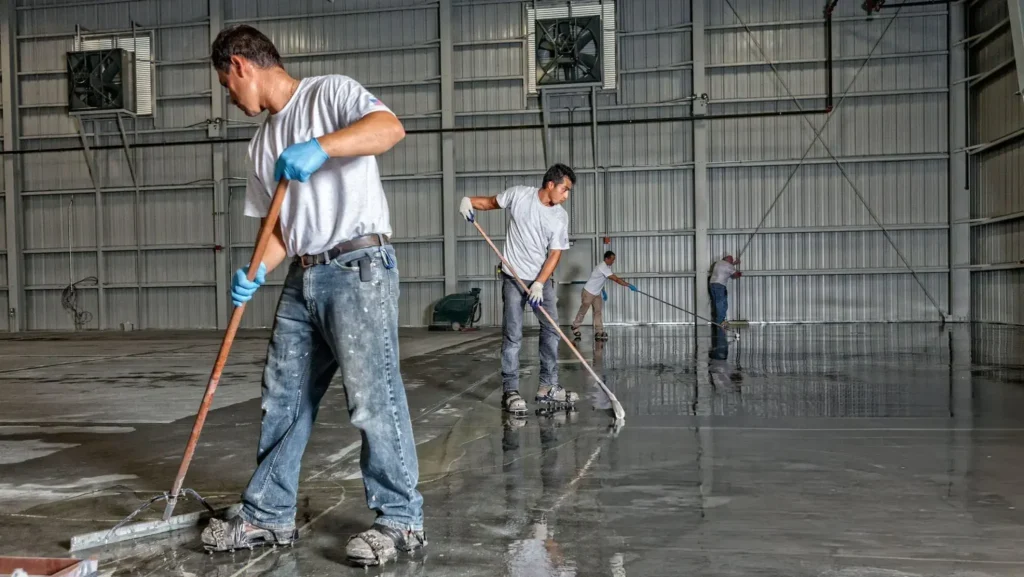Introduction
Epoxy floor coating has gained immense popularity as a durable, aesthetically pleasing, and versatile flooring solution for both residential and commercial spaces. Yet, one crucial question lingers for homeowners and businesses in Melbourne: How long does epoxy flooring last, especially given the city’s unique climate conditions? Melbourne’s climate is characterized by its unpredictability—hot summers, chilly winters, and fluctuating humidity levels. These factors can significantly impact the lifespan of epoxy flooring. In this guide, we’ll explore the durability of epoxy flooring, the specific challenges posed by Melbourne’s climate, and actionable steps to maximize its longevity.

Factors Affecting Epoxy Flooring Lifespan
The lifespan of epoxy flooring is influenced by several factors. Understanding these can help you make informed decisions when choosing and maintaining your flooring.
1. Quality of Materials
The quality of the epoxy resin and hardener plays a significant role in determining how long your flooring will last. High-grade epoxy products offer superior resistance to wear, impact, and chemical spills. Opting for lower-quality products may save money initially, but they often lack the durability required for long-term use, especially in climates like Melbourne’s.
- Pro Tip: When selecting epoxy, look for products labeled as “industrial-grade” or those designed for high-traffic areas.
2. Installation Process
Even the best materials won’t perform well if the installation process is flawed. Proper surface preparation is critical—this includes cleaning, repairing cracks, and ensuring the substrate is dry and free of contaminants. A poorly installed epoxy floor may peel, bubble, or crack prematurely.
- Pro Tip: Always hire experienced professionals who specialize in epoxy flooring and understand the challenges posed by Melbourne’s climate.
3. Exposure to Harsh Conditions
Epoxy flooring is renowned for its resilience, but prolonged exposure to harsh environmental conditions can reduce its lifespan. Factors such as UV radiation, temperature fluctuations, and moisture can all contribute to wear and tear.

How Melbourne’s Climate Impacts Epoxy Flooring
Melbourne’s climate poses unique challenges for epoxy flooring. Understanding these conditions can help property owners take proactive measures to protect their investment.
1. Hot Summers and Cold Winters
Melbourne experiences hot summers with temperatures often exceeding 40°C, followed by cold winters with lows nearing 0°C. These extreme temperature fluctuations can cause the concrete substrate to expand and contract, potentially leading to cracks in the epoxy layer.
- Solution: Use flexible epoxy formulations designed to withstand temperature shifts without cracking.
2. Humidity and Moisture Considerations
Humidity is another key factor in Melbourne, particularly during the wetter months. Moisture can seep into the concrete substrate, leading to adhesion problems or bubbling in the epoxy layer.
- Solution: Ensure proper moisture testing before installation and consider using a moisture barrier primer if needed.
3. Coastal and Urban Environments
Coastal areas around Melbourne expose epoxy floors to salt air, which can accelerate wear, while urban environments with heavy foot and vehicle traffic add to the stress on flooring.
- Solution: In coastal areas, consider UV-stable epoxy coatings to resist degradation, and in urban settings, opt for abrasion-resistant finishes.

Tips for Extending the Lifespan of Epoxy Flooring
While Melbourne’s climate presents challenges, there are several practical steps you can take to ensure your epoxy flooring lasts as long as possible.
1. Regular Cleaning and Maintenance
Dirt and debris can act like sandpaper underfoot, gradually wearing down the epoxy surface. Regular sweeping and mopping will help maintain its appearance and integrity.
- Pro Tip: Use a pH-neutral cleaner specifically designed for epoxy floors to avoid damaging the finish.
2. Protecting the Floor from Excessive Wear and Tear
Excessive weight, sharp objects, and chemical spills can damage epoxy flooring over time. Use protective mats in high-traffic areas and under heavy equipment.
- Pro Tip: For garage or industrial floors, consider adding a polyurethane topcoat for extra durability against mechanical and chemical stress.
3. Addressing Damage Promptly
Small cracks or chips in the epoxy layer can worsen if left unaddressed. Regular inspections and prompt repairs will prevent minor issues from escalating into major problems.

Conclusion
Epoxy flooring is a durable and versatile option that can last anywhere from 10 to 20 years or more, even in Melbourne’s challenging climate. Key factors influencing its longevity include the quality of materials, the installation process, and the level of exposure to environmental stressors.
By understanding how Melbourne’s unique climate impacts epoxy flooring and implementing proper maintenance practices, you can maximize its lifespan. Regular cleaning, protecting the floor from excessive wear, and addressing damage promptly are all essential steps.
For those considering epoxy flooring or seeking professional maintenance advice, consulting with an expert can make all the difference. A well-installed and maintained epoxy floor is not only a practical choice but also an investment that enhances the value and functionality of your property.
Ready to protect your epoxy flooring investment? Contact our team of experts for a consultation on installation, maintenance, and repair services tailored to Melbourne’s climate. Don’t forget to share this post with others looking for durable flooring solutions!





0 Comments